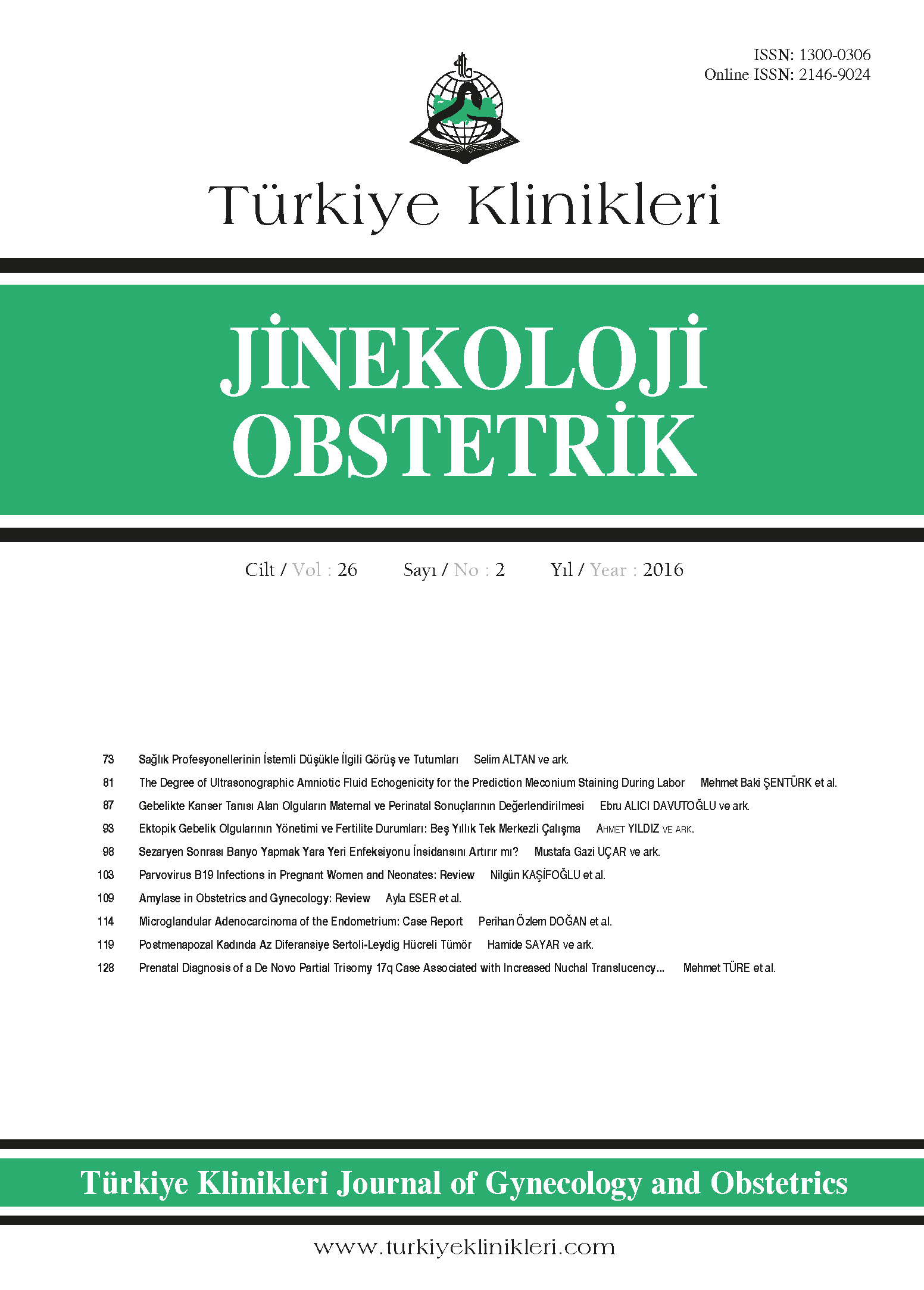Open Access
Peer Reviewed
CASE REPORTS
3228 Viewed1406 Downloaded
Prenatal Diagnosis of a De Novo Partial Trisomy 17q Case Associated with Increased Nuchal Translucency, Hypoplastic Left Heart Syndrome, Cerebral Anomalies: Case Report
Artmış Ense Kalınlığı, Hipoplastik Sol Kalp Sendromu, Serebral Anomaliler ile İlişkili De Novo Parsiyel Trizomi 17q'lu Olgunun Prenatal Tanısı
Turkiye Klinikleri J Gynecol Obst. 2016;26(2):125-8
DOI: 10.5336/gynobstet.2014-40704
Article Language: EN
Article Language: EN
Copyright Ⓒ 2025 by Türkiye Klinikleri. This is an open access article under the CC BY-NC-ND license (http://creativecommons.org/licenses/by-nc-nd/4.0/)
ABSTRACT
Partial trisomy of distal 17q is rare. Until now, 32 cases of partial trisomy for the distal region of 17q were reported. Our case has multiple anomalies, such as increased nuchal translucency, hypoplastic left heart syndrome and cerebral anomalies by routine prenatal ultrasonografic screen. Our case's karyotype was determined as 46,XX,der(4)(17qter→17q21::4pter→4qter)dn due to de novo chromosomal rearrangement. Cytogenetic results performed with FISH analysis. Our case is the first reported case of a de novo derivative chromosome 4 arising from partial trisomy 17q. The 4p terminal deletion was not determined by FISH with the 4p telomere probe so we considered that the clinical findings of our case associated with partial trisomy 17q. We have reported this case to contribute to the literature and to provide benefit in the genetic counceling.
Partial trisomy of distal 17q is rare. Until now, 32 cases of partial trisomy for the distal region of 17q were reported. Our case has multiple anomalies, such as increased nuchal translucency, hypoplastic left heart syndrome and cerebral anomalies by routine prenatal ultrasonografic screen. Our case's karyotype was determined as 46,XX,der(4)(17qter→17q21::4pter→4qter)dn due to de novo chromosomal rearrangement. Cytogenetic results performed with FISH analysis. Our case is the first reported case of a de novo derivative chromosome 4 arising from partial trisomy 17q. The 4p terminal deletion was not determined by FISH with the 4p telomere probe so we considered that the clinical findings of our case associated with partial trisomy 17q. We have reported this case to contribute to the literature and to provide benefit in the genetic counceling.
ÖZET
Distal 17q'nun parsiyel trizomisi nadirdir. Bugüne kadar distal 17q parsiyel trizomili 32 olgu rapor edilmiştir. Bizim olgumuz rutin prenatal ultrasonografi ile tespit edilmiş artmış ense kalınlığı, hipoplastik sol kalp sendromu ve serebral anomaliler gibi pek çok anomalilere sahiptir. Olgumuzun karyotipi de novo kromozomal yeniden düzenlenmeye bağlı 46,XX,der(4)(17qter→17q21::4pter→4qter)dn olarak belirlendi. Sitogenetik sonuçları FISH analizi ile doğrulandı. Bizim olgumuz, parsiyel trizomi 17q'dan kaynaklanan de novo derivatif kromozom 4'e ait bildirilen ilk vakadır. 4p telomer probu ile yapılan FISH analizinde 4p terminal delesyonu saptanmadığından olgumuzun klinik bulgularının parsiyel trizomi 17q ile ilişkili olduğunu düşünüyoruz. Bu vakayı, literatüre katkı sağlamak ve genetik danışma süresine yardımcı olmak amacıyla bildirdik.
Distal 17q'nun parsiyel trizomisi nadirdir. Bugüne kadar distal 17q parsiyel trizomili 32 olgu rapor edilmiştir. Bizim olgumuz rutin prenatal ultrasonografi ile tespit edilmiş artmış ense kalınlığı, hipoplastik sol kalp sendromu ve serebral anomaliler gibi pek çok anomalilere sahiptir. Olgumuzun karyotipi de novo kromozomal yeniden düzenlenmeye bağlı 46,XX,der(4)(17qter→17q21::4pter→4qter)dn olarak belirlendi. Sitogenetik sonuçları FISH analizi ile doğrulandı. Bizim olgumuz, parsiyel trizomi 17q'dan kaynaklanan de novo derivatif kromozom 4'e ait bildirilen ilk vakadır. 4p telomer probu ile yapılan FISH analizinde 4p terminal delesyonu saptanmadığından olgumuzun klinik bulgularının parsiyel trizomi 17q ile ilişkili olduğunu düşünüyoruz. Bu vakayı, literatüre katkı sağlamak ve genetik danışma süresine yardımcı olmak amacıyla bildirdik.
KEYWORDS: Chromosome 17 trisomy; prenatal diagnosis
MENU
POPULAR ARTICLES
MOST DOWNLOADED ARTICLES





This journal is licensed under a Creative Commons Attribution-NonCommercial-NoDerivatives 4.0 International License.










